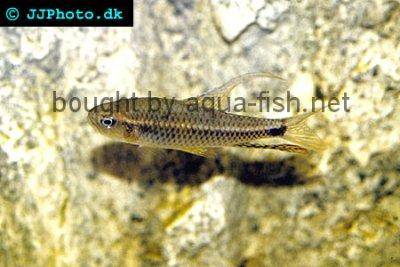Sailfin tetra - Crenuchus spilurus
Scientific name: Crenuchus spilurus
Common name: Sailfin tetra
Family: Crenuchidae
Usual size in fish tanks: 5 - 6 cm (1.97 - 2.36 inch)
014
Recommended pH range: 6.2 - 7.1
Recommended water hardness: 4 - 16°N (71.43 - 285.71ppm)
0°C 32°F30°C 86°F
Recommended temperature range: 23 - 28 °C (73.4 - 82.4°F)
The way how these fish reproduce: Spawning
Where the species comes from: South America
Temperament to its own species: peaceful
Temperament toward other fish species: peaceful
Usual place in the tank: Top levels
Origin
South America; Sailfin tetras are to be found in the Amazonian River Basins of Brazil.
Lifespan
The expected life span for Crenuchus spilurus is 3 years.
Short description
Keep Crenuchus spilurus in small groups of at least 6 members. They prefer acidic water and a heavily planted tank. They can tolerate harder water but require high water quality. In their natural habitat they tend to live in waters that are dimmed by a lot of overhead vegetation, this can easily be replicated in the aquarium by the use of floating plants. Bright lighting can make these fish feel more insecure and skittish. Sand should be used for the substrate and the addition of rocks or wood will provide them with hiding places if they have the need to use them.The use of tannins on the water will also be appreciated, blackwater extract is ideal for this, they normally inhabit stained and acidic waters in the wild. The Sailfin tetra is classed as a timid species and such such should not be housed with species known to be aggressive as they cannot compete against these, always keep them with other peaceful species that are of a similar size.
Food and feeding
Sailfin tetras should accept all foods offered. Use a quality flake or pellets for the staple diet and twice weekly give the fish treats of live or frozen blood worms, brine shrimp or daphnia.
Sexing
Males will have extended dorsal and anal fins with a gold edging to them.
Breeding
These tetras have taken on a breeding style similar to most of the dwarf cichlids. They are cave spawners and will deposit the eggs on the roof of any cave that is safe from predators. Spawning time is the only time that the males will become slightly territorial, each male will make its own area of the aquarium his own and entice the female over to swoon her into spawning. The eggs are deposited on the roof of the chosen cave, upturned terracotta plant pots are ideal but once spawning is complete, the male will take on the parental care with the female being chased out of the cave.The eggs will hatch after 2 days and the fry will be free swimming a few days later. The fry will accept newly hatched brine shrimp immediately and are fast growers.
You may find that once you start to breed these fish that you will have no success with the first few batches, this is perfectly normal as the parent fish need to learn how to become good parents. The may even eat the first couple of batches but in time you will get success and they will produce a lot of fry.
Pictures
Bought by aqua-fish.net from jjphoto.dk.



